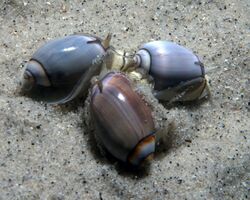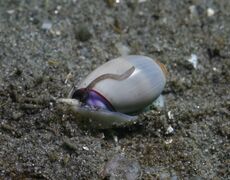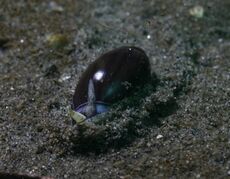Biology:Callianax biplicata
| Callianax biplicata | |
|---|---|
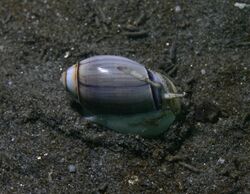
| |
| Scientific classification | |
| Kingdom: | |
| Phylum: | |
| Class: | |
| (unranked): | |
| Superfamily: | |
| Family: | |
| Genus: | |
| Species: | C. biplicata
|
| Binomial name | |
| Callianax biplicata Sowerby, 1825
| |
| Synonyms | |
| |
Callianax biplicata, common names the "purple dwarf olive" "purple olive shell" or "purple olivella" is a species of small predatory sea snail, a marine gastropod mollusc in the family Olivellidae, the dwarf olives. [1]
Distribution
Callianax biplicata snails are found in the Eastern Pacific Ocean coasts from British Columbia, Canada to Baja California, Mexico.[2]
Habitat
This species is common on sandy substrates intertidally and subtidally, in bays and the outer coast.[2]
Life habits
These snails are carnivorous or omnivorous sand-burrowers.
Shell description
This shell of this species is quite solid, and large for an Olivella, with adult shells ranging from 20 mm to 27 mm in length, about one inch. The shell is smooth, shiny, and is an elongated oval in shape. The shell is often some shade of greyish purple, but it can also be whitish, tan, or dark brown. On the darker color forms there is often some rich yellow above the suture on the spire.
At the anterior end of the long narrow aperture there is a siphonal notch, from which the siphon of the living animal protrudes.
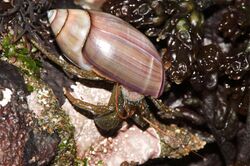
Human use
Native people of central and southern California used the shell of this species to make decorative beads for at least the last 9,000 years.[3] Such beads have been discovered in archaeological contexts as far inland as Idaho and Arizona.[4] Within the past 1,000 years these beads began to be manufactured in large quantities on southern California's Santa Barbara Channel Islands, indicating that they were used for shell money.[5] The historic Chumash people called them anchum.[6]
Notes
- ↑ MolluscaBase eds. (2021). MolluscaBase. Callianax biplicata (G. B. Sowerby I, 1825). Accessed through: World Register of Marine Species at: http://marinespecies.org/aphia.php?p=taxdetails&id=1424883 on 2021-11-04
- ↑ 2.0 2.1 Dave Cowles. 2005. Olivella biplicata (Sowerby, 1825) . accessed 22 November 2008.
- ↑ Bennyhoff and Hughes 1987
- ↑ Fitzgerald et al. 2005
- ↑ Arnold and Graesch 2001
- ↑ Daily Life in a Chumash village . last change 4 August 2005, accessed 22 November 2008.
References
- Arnold, J.E. and A.P. Graesch. 2001. The Evolution of Specialized Shellworking Among the Island Chumash. In The Origins of a Pacific Coast Chiefdom: the Chumash of the Channel Islands, edited by J.E. Arnold, pp. 71–112. Salt Lake City: University of Utah Press.
- Bennyhoff, James A. and Richard E. Hughes. 1987. Shell Bead and Ornament Exchange Networks between California and the Western Great Basin. Anthropological Papers of the American Museum of Natural History 64:79-175.
- Fitzgerald, Richard T., Terry L. Jones, and Adele Schroth. 2005. Ancient Long Distance Trade in Western North America: New AMS Radiocarbon Dates from Southern California. Journal of Archaeological Science 32:423-434.
- McLean, J.H. (2007) Gastropoda. In Carlton, J.T. (Ed.) Light and Smith's Manual. Intertidal Invertebrates of the Central California Coast. University of California Press, Berkeley, pp. 713-753
- Powell II, C. L.; Vervaet, F.; Berschauer, D. (2020). A taxonomic review of California Holocene Callianax (Olivellidae:Gastropoda:Mollusca) based on shell characters. The Festivus. Supplement - special issue, 1-38.
External links
- Sowerby, G. B., I. (1825). A catalogue of the shells contained in the collection of the late Earl of Tankerville : arranged according to the Lamarckian conchological system: together with an appendix, containing descriptions of many new species London, vii + 92 + xxxiv pp
- Oldroyd, T.S. (1918). Olivella biplicata angelena, var. nov. The Nautilus. 32(1): 34- 35
- Vanatta, E.G. (1915). Notes on Oliva. The Nautilus. 29(6): 67-75
- "Olivella biplicata". Integrated Taxonomic Information System. https://www.itis.gov/servlet/SingleRpt/SingleRpt?search_topic=TSN&search_value=74225.
Wikidata ☰ Q3173525 entry
